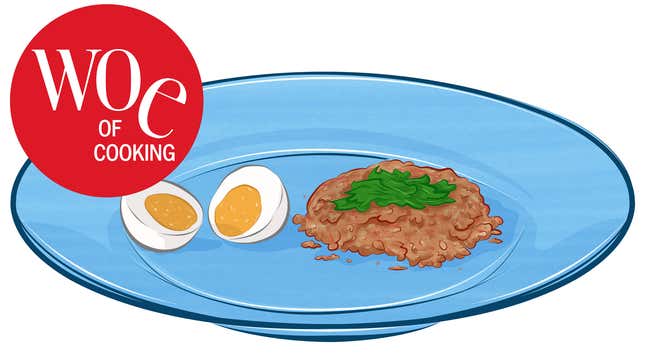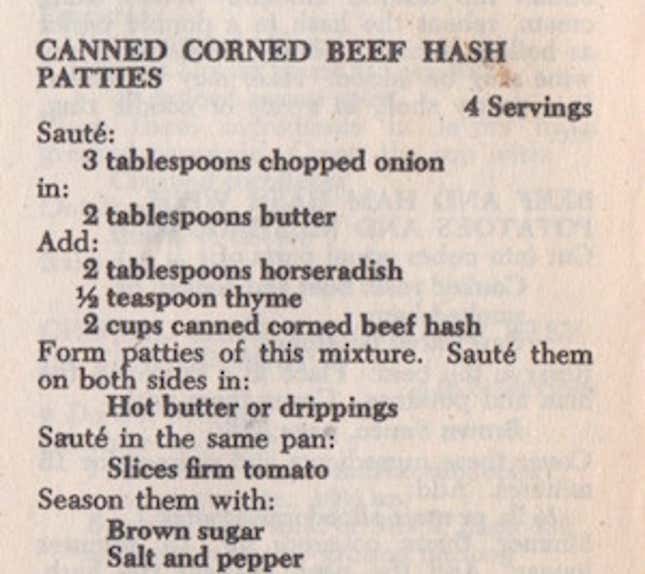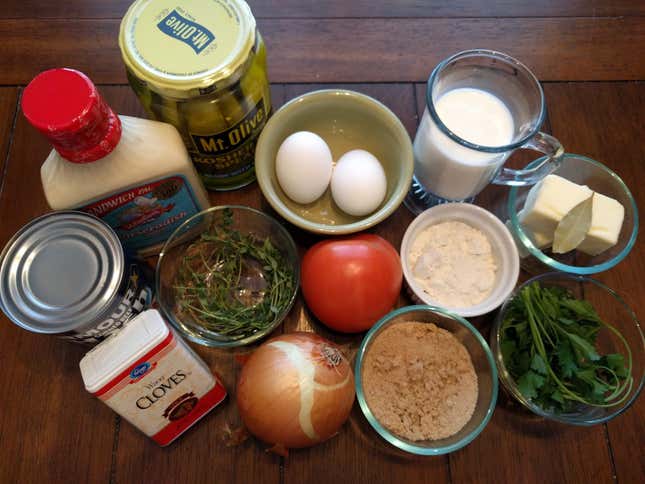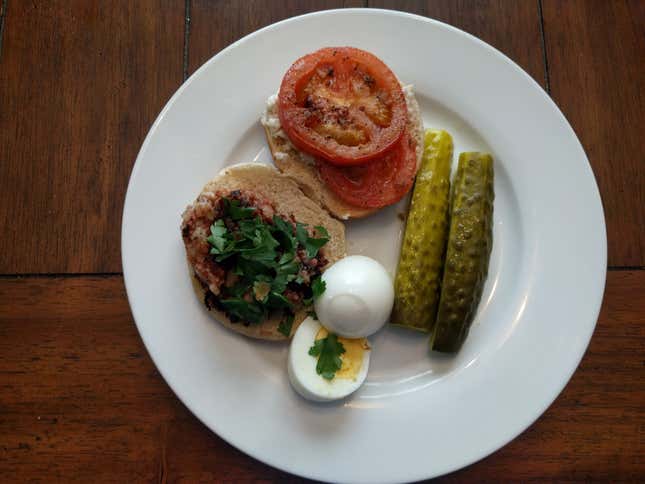
The Woe of Cooking is an ongoing fiasco where Jesse Farrar unearths the weirdest, grossest recipes he can find in The Joy of Cooking, and cooks/eats them. It has been awhile; we missed you.
J. Kenji Lopez-Alt’s intimidatingly comprehensive The Food Lab describes hash as a hangover cure, a last-minute meal, and the “ultimate leftover-consumer.” But like athletes, whose talents and achievements we regularly and stubbornly insist must be comparable across the decades, most food demands the context of its respective historical era. An analysis of the flavor of mashed potatoes in 1840s Ireland, to pick a relevant example, would not necessarily tell the whole tale. That can be difficult to remember in 2016.
The Food Lab, which is really more of a luxurious bookshelf decoration than a nightly recipe resource, runs to nearly 1,000 pages, has an MSRP of $49.95, and features a lovely gold inlay on its minimalistic, stark white hardcover. I have had it for less than one month, and its blemishes already taunt me like scuffs on my first pair of Jordans. This book is the product of a year in which it seems like a good idea to give a random 7/11 shopper nearly a billion and a half dollars—a time that, though its rents are indisputably too damn high, is nevertheless one of outrageous surplus and prosperity compared to hash’s heyday: the Great Depression.

To you, hash may be the morning-afterthought breakfast you slap together half-drunk in a trendy urban loft, but that’s only because gentrification is your motif this month. The truth is that it’s a poor man’s meal with timid flourishes strictly on occasion and when circumstances allow. Hash, like so many meals of its time, is a subsistence food. Nothing more and nothing less.
In other words, it’s garbage beef, and you’ll love it. This is how we do.
First, stock your larder.

You’ll need everything easily identifiable in this photo, and then, depending on your aptitude for parsing grocery items from a top-down view, you will also need flour, a can of corned beef hash, horseradish, thyme, and parsley. The stuff in the cup is milk. You got that it’s milk, right? It’s cow’s milk. Yeesh.
(A quick note here: the Joy of Cooking recipe calls for simply “horseradish,” and not horseradish sauce. I elected to use the latter, which, having actually finished the recipe by this point, I recognize could have been in error. However, I will defend your right to use the sauce over the plant in part because the spirit of the dish is frugality, which presumably was serviced in Ms. Rombauer’s case by picking up some of the spicy root on her way back from the garden and is perfectly analogous to our not spending $8 on a now-obscure, difficult to deploy, and quick to spoil ingredient. Plus, you could spend the next two weeks hunched over your counter, grating your fingers to the bone, and no one undiscerning enough to let you cook them something a fat internet guy said he read about in an old book will know the difference, so maybe just skip radishes altogether if you don’t wanna buy the goop.)
Joy has this funny little habit of pulling you into a recipe with a simple introduction, only to ambivalently snap its jaws around your neck in the third to last line with some complicated, daisychain opus of a step. It’s like being married. It’s Friday night, the kids are in bed, you’ve had y=(x-3) beers, where x is the number of beers you have actually had and y is the number of beers you tell your wife you had, and you’re just about to close your eyes, and then your lovely bride of 10 years whispers sensually in your upturned ear, “My parents are coming over tomorrow at 7 a.m.” Bah! No.
So instead of waiting until the end of the spiel to tell you that hard-boiled eggs are once again a suggested pairing, I’ll say it now: boil some eggs, if you want. You may also preheat the oven to 350 degrees, which Rombauer was thoughtful enough to write nearly a hundred pages later. While all that’s going, you may chop about 3 tablespoons worth of onion (a quarter, at most) and sauté it in 2tbs of butter. Do so in a nonstick pan, please, unless you are extraordinarily confident in your ability to pry an unfamiliar ground meat off a surface so hot and clingy that it makes pre-2015 Jennifer Aniston look carefree by comparison. But we’re getting ahead of ourselves.
Next, do something absolutely crazy. Specifically, Rombauer directs us to dump our horseradish, thyme, and canned corned beef hash into the pan. Now, you will recall that this is a pan teeming with sizzling onions. Moreover, it is clear that this amount of famously fragrant bulb could not possibly absorb the butter in which it is floating any more than it could pop out into the kitchen and explain intersectional feminism to you. On top of that, the corned beef hash is not exactly dusty-ass, dry-ass Ragnarok rations, ya know? We’re talkin’ Fancy Feast moisture levels, here. Then again, the can also has onions already in it, too, so maybe doubling down is a theme with hash. I don’t know, I’m not 200 years old.
Now that you’ve got a sauté pan full of fatty water, it’s time to throw one last ingredient in there, and you’ve probably seen it coming a mile away: sliced tomatoes seasoned with brown sugar, salt, and pepper. Of course! That old staple. We all love it, can’t get enough of it, and doctors are telling us to cut back but we just can’t. You probably have some tomatoes with brown sugar, salt, and pepper already going on a different part of the stove, so just flip a couple over into this pan and be done with it. Before browning and flipping, it should look a little something like this:

I regret showing you this mess, but it helps illustrate the problem with the dish. First of all, it’s stupid. Secondly, and more importantly, there is an abundance of fat and water in there, and the “patties”, such as they are, shan’t be shaping up anytime soon. In the interest of full disclosure, I am not totally sure why. It’s possible that I borked this whole thing up with the liquid ’radish and the stickable pan. Or maybe, as some of the internet’s more enthusiastic Hash Heads have suggested, they just don’t make canned corned beef like they used to. Regardless, unless you want to dump this junk out onto a paper towel and wring it dry like a pair of gym shorts or leave it simmering until the pan rivets melt, you’re probably going to be eating some crumbly hash. I’m guessing if you’ve come this far, though, that you’re mostly okay with that.
On the other hand, if you got all cocksure and invited a bunch of people over to try your one-of-a-kind, world-famous corned beef hash before you even tried making it, you may need an insurance policy so you don’t look like the world’s dumbest ass. I would suggest takeout. The Joy of Cooking, on the other hand, suggests béchamel. Ugh.
Béchamel sauce, known as “Cream Sauce I” in my edition, “Boss Sauce” in some, and “The Big Wet” in others, is a classic French mother sauce, i.e. it’s in a lot of different shit. It starts with a roux, which is simple enough, so make that.
To do so, you’ll need those two tablespoons of butter from before, and you’ll need to melt them in a non-nonstick pan (this one is going into the oven, which should be preheated by now, and which doesn’t mess around with Teflon) on very low heat. Slowly integrate about 2tbs of flour into the melted fat, blending thoroughly. This mixture is the base of the roux, and getting it right is extremely important, so take your time. A good roux is like Boogie Cousins—it’s a terrific foundation, but knowing that is no great skill. There’s more to a meal than just butter paste. It’s how you build around the roux that truly matters. If you wanna stick a bunch of Omri Casspis in your roux, then you deserve how it turns out. I can’t help ya.
Next, add a cup of milk slowly—but not too slowly, or the sauce will seize up on you something fierce—and whisk it all into submission. Toss half a bay leaf in there, dramatically, like you pulled the pin on a flavor grenade. Then stick a couple of cloves into an onion like a smelly voodoo doll, and put that in there, too. I used the leftover onion from the hash recipe, but maybe you want to up the ante and use a different onion. You do you.
Here’s where we get wild. Are you ready? The whole pan, onions and all, goes in the oven for 20 minutes. Ideally, it should be less than 20 minutes, since I went by the book, and it turned my delicate, bright béchamel into the world’s worst mashed potatoes. This shit was like donut dough. Moral of the story: watch your sauce.
So here we are. We have gummy cream; a lot of crumbly, burnt trash meat (yeah, I burnt the shit out of the hash, too); and a few boiled eggs. What would a family of walking, talking ballcaps do with this mess? Probably this:

A burger, why not?! Well, because that’s a hell of a lot of work for a burger, in short. I won’t insult you by insisting how, in the end, it was all worth the (considerable pan-scrubbing) effort, either.
I think I could have enjoyed all of the constituent parts separately—a tomato here and a corned beef there—but something about putting them in one big pile simply didn’t work for me. Perhaps in a bygone era, when the highest-quality beef was shipped to the cannery and extruded into pie filling, I could enjoy a dinner of “Canned Corned Beef Patties.” But not today. Not when I could eat Mountain Dew chicken wings instead.
Thank God for the New Deal. Being poor is for the birds.
Lead image by Sam Woolley.